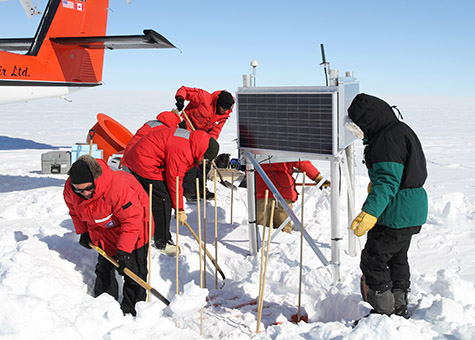
In March 2010, the ice sheets in Antarctica vibrated a bit more than usual as a surface wave from an 8.8-magnitude earthquake in Chile 3,000 kilometers away passed through the ice. Powerful earthquakes were known to trigger secondary quakes along faults in land; this was the first observation of triggered quakes in the ice.
Washington University in St. Louis seismologist Doug Wiens, PhD, says the finding is one of several discoveries made possible by POLENET, an array of seismic stations that reaches for the first time into the interior of Antarctica.
Seismic events aren’t rare occurrences on Antarctica; in some parts of the continent, ice deformation gives rise to hundreds of icequakes an hour. But a study of the seismic signals following the 2010 earthquake published in the Aug. 11 issue of Nature Geoscience is the first to indicate that Antarctica’s ice sheets are sensitive to distant earthquakes.
While examining the signals from stations in the Southern Hemisphere, Zhigang Peng, PhD, an associate professor in the School of Earth and Atmospheric Sciences at Georgia Tech, noticed that a few stations in Antarctica recorded shaking shortly after the Chilean earthquake.
Peng, an expert in triggered earthquakes, and Georgia Tech postdoctoral student Jake Walter, PhD, now a research scientist at the University of Texas in Austin, analyzed the signals, in consultation with four seismologists in the POLENET network who were more familiar with the behavior of seismic waves in ice.
Seismic waves from large earthquakes can almost instantaneously trigger shallow micro-earthquakes and deep tectonic tremor as they pass through Earth’s crust. But nobody had thought to look for triggered quakes in ice sheets, in part because there had been few stations to record them.
To distinguish triggered quakes from other activity, the team isolated high-frequency component in the seismic signals from 42 stations in the six hours before and after the 3:34 a.m. event. Nearly 30 percent (12 of the 42 stations) picked up high-frequency seismic signals as a surface-wave from the remote epicenter arrived in Antarctica.
“We interpret these events as small icequakes, most of which were triggered during or immediately after the passing of long-period Rayleigh waves generated by the Chilean mainshock,” said Peng, who led the study.
“Rayleigh waves are waves localized along the surface of Earth much as ocean waves are localized along the surface of the ocean,” said Wiens, a professor of geology in Arts & Sciences, and one of the consulting seismologists. “Earthquakes generate both surface waves and body waves, but it was the surface waves, which have the largest amplitude, that triggered the icequakes,” he said.
“Because Antarctica is so far from Chile, the seismic waves were weak and the changes to the stress in the ice sheet small,” Wiens said. “This means the icequakes must have been ready to let go; there wasn’t much friction holding them back.”
Were the triggered quakes caused by sudden changes in glacier flow as ice slipped at its base or by the opening of crevasses at the surface? The scientists aren’t sure. “Unfortunately we weren’t able to localize them very well,” Wiens said.
“However, some of the icequakes themselves created surface waves, so they were probably very close to the ice surface,” said Peng. “While we cannot be certain, we suspect the near-surface ice fractured as the ice was expanded and compressed by the passing of the Rayleigh wave from the distant earthquake.”
Installing a denser seismic array is a bit like building a telescope with a bigger mirror. Things seen dimly before are now in clear focus and things not seen at all may suddenly pop into focus. In 2010, POLENET revealed a previously unknown volcano smoldering under the ice sheet. Now we learn that distant earthquakes shake the ice as well. Who knows what other surprises the new seismic array will reveal?
This release is based on the release written by Jason Maderer of Georgia Tech.